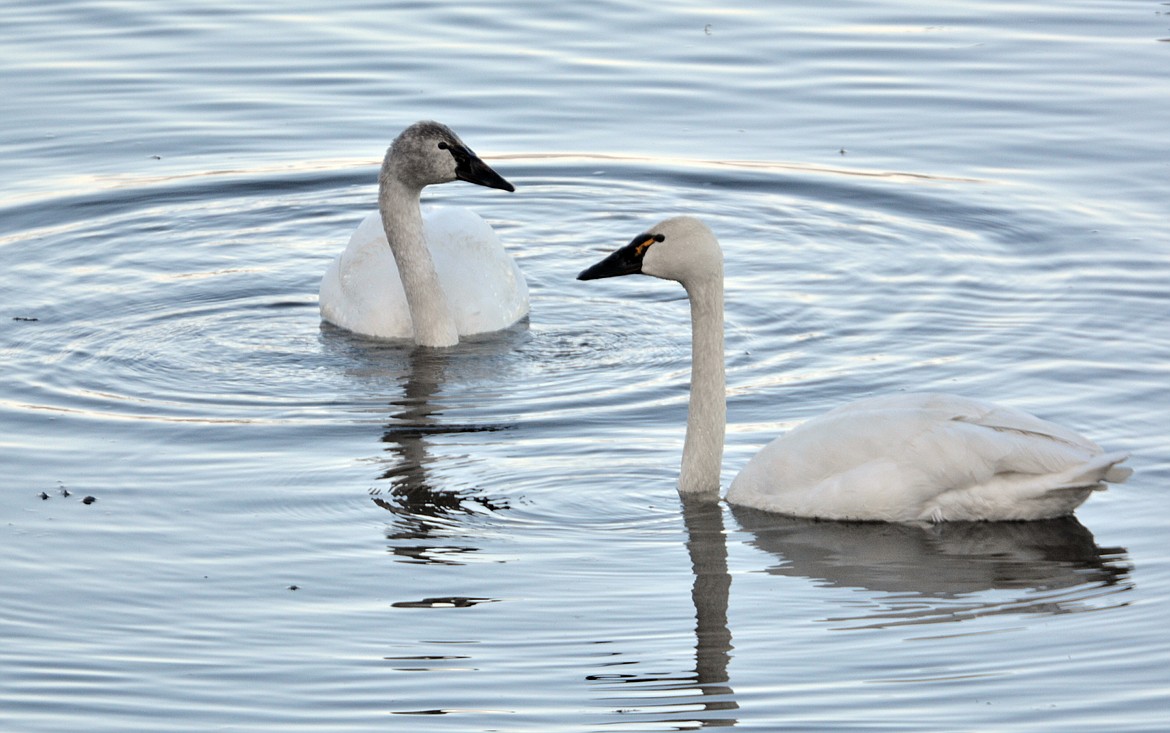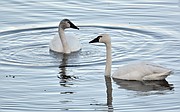Tundra swans stop over for bed and breakfast!
“If you can add a great beauty to something which is already beautiful, then you must be very beautiful like a white swan adding beauty to a misty lake!”
— Mehmet Murat ildan (author)
As I watch hundreds of tundra swans from the north bank of McArthur Lake last week I was in awe of their beauty and the whistling sound from their wings as they came close. The tundra swan is also called the “whistling swan” because of the sound made by the beating of the bird’s wings in flight. The tundra swan is the most common species of swan in the United States and Canada.
Tundra swans are large birds with long necks. They have white feathers and black legs, feet and beak. They can be as large as four feet from beak to tail. An adult male weighs about 16 pounds and an adult female weighs about 13 pounds. They make a soft, melodious sound. In large migrating groups, they sound much larger than one on its own.
In the heart of Boundary County, the Kootenai Valley is just beginning to awaken from its winter sleep. In May and June, this valley becomes a lush and gorgeous green.
This area is about to be the setting of a truly remarkable annual event in the natural world. As the frozen floor of the Kootenai Valley thaws, it becomes a prime destination and spring feeding grounds for thousands of waterfowl: Canada geese, pintails, buffleheads, mallards, goldeneyes, coots and the highly anticipated tundra swans.
Starting from as far away as New Mexico and California, tundra swans make their way north to their breeding grounds on the Arctic tundra, the origin of their name. For a short time along their migration route, they stop in Boundary County on several lakes and ponds such as McArthur Lake, Kootenai National Wildlife Refuge and Boundary Creek /Smith Creek Wildlife Management Unit.
These lakes and ponds nearly dry up in summer. However, in the spring, the lake and ponds resemble a floodplain, with an average depth of one to three feet. Ideal feeding conditions for waterfowl that eat plants from shallow bodies of water. This spring conditions are prime for large numbers of tundra swans to stop for bed and breakfast in Boundary County as they have historically done over the years.
Generally, mature trumpeter swans are larger than tundras, but this size difference is not always obvious unless both species are viewed together. Trumpeters have a longer and flatter bill, and the black eye is continuous with the black bill. The tundra swan has a shorter bill with more of a curve, and the black eye is still connected but more separated from the bill. Most tundra swans also have a small yellow spot in front of the eye, although a small percent do not. But truthfully, a day spotting either a tundra or trumpeter swan is a good day, as both are spectacular.
Watching the swans quickly transports me from my busy life of retirement and into the world of these remarkable birds. The rhythm and simplicity of their activities is oddly comforting, as I watch them swimming, feeding, and displaying mating and territorial behaviors. If the light is just right, their outstretched wings present a scene that is breathtaking.
When they leave Boundary County they will spend the summer on the tundra of the Canadian Arctic and Alaska. A male and female swan will usually spend one year as a pair. This pair defends a territory of about two square yards. Each pair will build a nest near a pond or lake. The nest is large and round. It is made of sticks and lined with moss and grasses. A female tundra swan will usually lay about four eggs. The eggs are large and cream colored. The female will sit on the eggs for 32 days, waiting for them to hatch.
I hope to see them next fall when they migrate south and stop for “Bed and Breakfast” in Boundary County”!
Enjoy the outdoors, it is spring!



